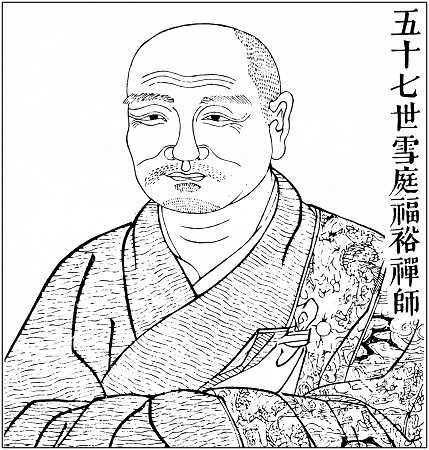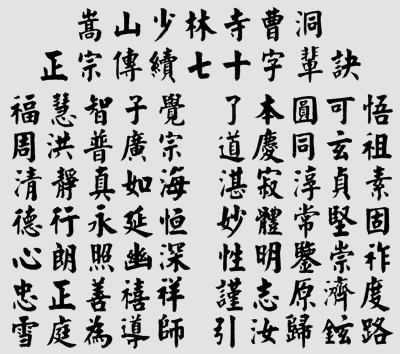ZEN MESTEREK ZEN MASTERS
« Zen főoldal
« vissza a Terebess Online nyitólapjára

雪庭福裕 Xueting Fuyu (1203-1275)
(Rōmaji:) Settei Fukuyū
Xueting Fuyu (雪庭福裕), 1203–1275, was an abbot of the Shaolin Monastery of the Caodong lineage. He is famous for inviting all of the martial artists in China to the Temple to discuss, practice, and fight, refining their technique into one Shaolin style. He held these symposiums three times, each for a period of three years. As the martial artists returned to their home towns, they brought back the Shaolin techniques with them. This is why so many Asian martial arts systems can trace their roots to the Shaolin Temple, and why the Temple is sometimes erroneously known as "The birthplace of martial arts".
Fuyu also wrote a 70-character generation poem that is used for generational naming at the Shaolin Temple. Each generation uses the next word in the poem. For example, the 29th abbot of the Shaolin Temple, Shi Xing Zheng, was of the 32nd generation, and Xing is the 32nd word in the poem.
In famous monasteries such as Shaolin, an “unbroken” dharma transmission has apparently been maintained since the Yuan. It is well known that Shaolin monastery was revived by Xueting Fuyu (1203–1275) during the early Yuan dynasty. Not only did he revitalize Shaolin as the ancestral monastery of Chan Buddhism, he also established the Caodong transmission there. [67] In the late Ming, dharma transmissions derived from him were still alive. To prove the authenticity and continuity of their dharma transmission, Chan practitioners often referred to the Shaolin lianfang bei (Inscription of linked flowers in Shaolin) as evidence. [68] The revived Caodong lineage in south China was indeed derived, at least nominally, from the Shaolin transmission.
67. For Xueting Fuyu's dharma transmission in Shaolin monastery, see Wu Limin et al., Chanzong zongpai yuanliu, pp. 458–74.
68. See Huanxiu Changrun's epitaph by Wang Daokun (1525–1593) in Shaolin si zhi , ZFS 6: 162, and also the dharma transmission of the Caodong lineage in ZFS 9: 192–93.
Source:
PDF: Enlightenment in Dispute : The Reinvention of Chan Buddhism in Seventeenth-Century China by Jiang Wu. New York: Oxford University Press, 2008
The Three Lineages of Shaolin
http://shaolinchancity.blogspot.hu/2008/12/three-lineages-of-shaolin_11.html
The Shaolin Monastery has had three distinct lineages (successions of abbots) in its history. The following is a general overview of each.
Batuo’s Lineage
In 495 A.D. the Shaolin Monastery was built in Henan province for an Indian monk named Buddhabhadra (Chin.: Fótuóbátuóluó 佛陀跋陀罗), and called "Batuo" (Chin.: Bátuó 跋陀) by the Chinese. He was given land at the foot of the Shaoshi Mountain (Chin.: Shàoshìshān 少室山) to build a monastery to teach the tradition of Nikaya Buddhism. The Shaolin name comes from the first character in the name Shaoshi Mountain, 少 shào, and the Chinese term for the surrounding woods, 林 lín.
The first lineage was very short. It consisted solely of Batuo, the founder of Shaolin Monastery, and he had few disciples. However, two former generals, Huiguang (Chin.: Huìguāng 慧光) and Sengchou (Chin.: Sēngchóu 僧稠), became his students and were the first to bring martial arts to the temple despite many who claim it was Bodhidharma who first introduced martial arts practice to unhealthy monks. So in fact martial arts practice has been a part of Shaolin Monastery from almost its beginning.
Batuo’s lineage ended 32 years later when Bodhidharma became abbot of the temple with the start of his newly founded Chan Buddhism (Chin.: chánzōng fójiào 禅宗佛教).
Damo’s Lineage
In 527 A.D. another Indian monk by the name of Bodhidharma (Chin.: Pútídámó 菩提达摩) known in China as “Damo” (Chin.: Dámó 达摩) arrived at the Shaolin Monastery and founded a new tradition known as Chan Buddhism, which was more suited to the Chinese and thus overtook Nikaya Buddhism as the tradition of the temple.
Chan is known in the West through its Japanese form of Zen. Chan and Zen have the same roots but have developed into culturally different practice traditions over the centuries. Upon becoming abbot of the Shaolin Monastery, Damo made a sort of prophecy. He tied six knots in the belt of his robe and stated that his lineage would end upon the fifth abbot following him. Damo’s disciple Huike (Chin.: Huìkě 慧可) became the second generation, Sengcan (Chin.: Sēngcàn 僧璨) the third, Daoxin (Chin.: Dàoxìn 道信) fourth, Hongren (Chin.: Hóngrěn 弘忍) fifth and Huineng (Chin.: Huìnéng 惠能) sixth. Not much is known about the early abbots following Huike as China was in the midst of a very warlike time. However, there are very important and famous Chan teachings left over from each of them.
Throughout the six generations of Damo’s lineage, the teaching of Chan Buddhism was passed through a mind to mind, heart to heart transmission, avoiding unnecessary verbal instruction. Huineng, the “wood chopper” who became enlightened upon hearing a certain line spoken by a man reciting the Diamond Sutra (Chin.: jīngāngjīng 金刚经) while chopping wood, was the first to have the teachings written down. Although he was known for being illiterate he may have had others write it down for him or others simply decided to do so. Either way it allowed the philosophy of Chan Buddhism to be spread but also marked the end of Damo’s lineage.
The Five Flavors of Chan
After the end of Damo’s lineage Chan Buddhism developed into five schools, or as we like to say; “flavors”, called the Caodong School (Chin.: Cáodòngzōng 曹洞宗), Linji School (Chin.: Línjìzōng 临济宗), Yunmen School (Chin.: Yúnménzōng 云门宗), Fayan School (Chin.: Fǎyǎnzōng 法眼宗) and Guiyang School (Chin.: Guīyǎngzōng 沩仰宗). Each differed in mixtures and methods of practice but still kept to the same philosophies of Damo and further of the original Buddha of our time, Shakyamuni Buddha (Chin.: Shìjiāmóunífó 释迦牟尼佛). Hence it is fitting that they be named “flavors” of Chan- different icings on the same cake.
Many of these secular Chan branches were obliterated during the Tang dynasty persecution of Buddhism (842-845). Nowadays, only Linji and Caodong survive. Centuries later at the Shaolin Monastery, being root of these five branches had its price. Turmoil had caused riots that resulted in the burning of the temple. This would not be the last time the temple would be burned.
Fuyu’s Lineage
After the death of Huineng a new generation of monks was started at the Shaolin Monastery. The first abbot of this new lineage was Xueting Fuyu (Chin.: Xuětíng Fúyù 雪庭福裕, 1203-1275). He renounced the world for monastic life, took the Dharma-name Fuyu and started studying under monk Wansong Xingxiu (Chin.: Wànsōng Xíngxiù 万松行秀).
When he came of age, the first emperor of the Yuan (Mongol) Dynasty Kublai Khan (Chin.: Yuán shìzǔ Hūbìliè 元世祖忽必烈, 1215-1294), sent him to Shaolin to restore order. Shaolin Monastery led the Caodong branch at Fuyu's abbacy.
Fuyu became abbot at a very warlike period of China’s history. He invited the best martial artists to come share their techniques while staying at the temple. Three times, for a period of three years each time, martial artists from many places came to the Shaolin Monastery to share their knowledge. The monks recorded the forms and techniques into a library kept at the temple. It is for this reason that Shaolin is often called the birthplace of martial arts, however this is not completely accurate. It can be seen more as a modern day university that simply studied martial arts and combined the useful techniques into a system. This system is known today by the temple's name, Songshan Shaolin (Chin.: Sōngshān Shàolín 嵩山少林) and has influenced the evolution of many following martial arts.
Abbot Fuyu’s lineage has remained unbroken to this day. He composed a Chan poem which became the source for Shaolin "character generation" (Chin.: zìbèi 字辈) naming which each master uses to give Dharma names to their disciples- each character in order representing their generation.
Shaolin Lineage
http://www.usashaolintemple.org/chanbuddhism-lineagepoem/
Shaolin Generational Naming
The abbot of the temple at the beginning of the Song Dynasty, Xueting Fuyu, wrote the following poem for the next generations to derive their names from. Chinese names usually consist of three words. Buddhist monks and Disciples worldwide take the last name "Shi" or "Shakya", for Shijiamouni (Shakyamuni) Buddha, to show they are part of his extended family. The first part of a given name is the generational name. For example, the given name of a monk or disciple of the 32nd generation would begin with the character "Xing", as it is the 32nd word in the poem.
A Seventy-character Rhyme of Genealogy for the Orthodox Caodong Sect of the Shaolin Buddhist Temple at Mt. Song
洞山下十五世 ( 萬松下法嗣 ) 少林祖庭雪庭福裕禪師從福字起演派七十字
福慧智子覺,了本圓可悟。
周洪普廣宗,道慶同玄祖。
清靜真如海,湛寂淳貞素。
德行永延恒,妙體常堅固。
心朗照幽深,性明鑒宗祚。
表正善禧祥,謹愨原濟度。
雪庭為導師,引汝歸鉉路。

Blessed and talented,
an intelligent young man will grow into awareness;
you are originally in a state of completion and thus apt to understand.
All around in the universe the Buddhist doctrine spreads,
we celebrate that our principle comes from the same ancestry.
The Buddhist state is pure and quiet, vast as the sea;
in the profound silence our chastity and nativeness are enhanced.
Our moral conduct will endure forever;
and our bodies are constantly firm.
The mind is a crystal clear that can light up the depth of the mountains;
and the innate character can make one bright enough
to distinguish nobility from treachery.
Faithfulness, decency and virtuousness will bring happiness and auspiciousness;
We cautiously keep in mind our original course in the crossing.
The snowy courtyard is like a teacher,
that will guide you to return to a bright road.
Shaolin
http://www.ottawakungfu.org/shaolin
History
http://www.ottawakungfu.org/shaolin/shaolin-history
The Origin of Wuseng
http://shaolinchancity.blogspot.hu/2009/01/origin-of-wuseng.html
Shaolin Monasticism & Discipleship
http://shaolinchancity.blogspot.hu/2008/12/shaolin-monasticism-discipleship_944.html